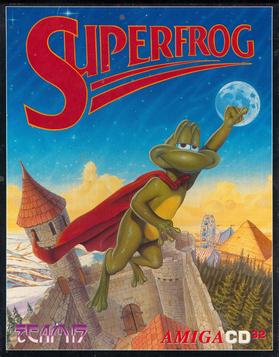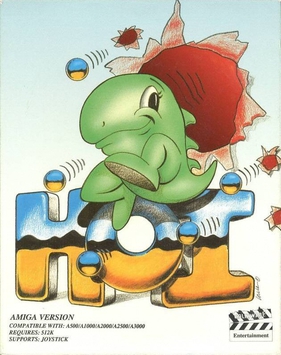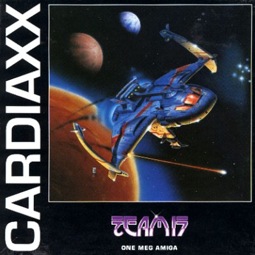
Rise of the Robots is a fighting game released by Time Warner Interactive in 1994. Originally developed for the Amiga and DOS by Mirage's Instinct Design, it was ported to various video game consoles, including the Super NES, the Mega Drive, and the 3DO Interactive Multiplayer. The game includes a single-player mode in which the player assumes the role of the ECO35-2 Cyborg as he attempts to stop the Supervisor who takes over Electrocorp's facilities in Metropolis 4, and a two-player mode in which the second player controls a character chosen from among EC035-2's enemies.
Shoot 'em ups are a sub-genre of action games. There is no consensus as to which design elements compose a shoot 'em up; some restrict the definition to games featuring spacecraft and certain types of character movement, while others allow a broader definition including characters on foot and a variety of perspectives.

Alien Breed is a top down run and gun video game released in 1991 by Team17 for the Amiga and later in 1993 by MicroLeague for MS-DOS. The game is the first in the Alien Breed series.

Lethal Xcess, also known as Lethal Xcess: Wings of Death II or just Wings of Death II, is a shoot 'em up game developed by two members of demo crew X-Troll and published by Eclipse Software in 1991 for the Atari ST and Amiga. It is a sequel to 1990's Wings of Death, in which its wizard hero goes into the far future to fight the descendants of the evil witch that he had defeated in the first game. Despite having been acclaimed by critics, the game was a commercial failure.

Paradroid is a Commodore 64 computer game written by Andrew Braybrook and published by Hewson Consultants in 1985. It is a shoot 'em up with puzzle elements and was critically praised at release. The objective is to clear a fleet of spaceships of hostile robots by destroying them or taking them over via a mini-game. It was later remade as Paradroid 90 for the Commodore Amiga and Atari ST home computers and as Paradroid 2000 for the Acorn Archimedes. There exist several fan-made remakes for modern PCs. In 2004 the Commodore 64 version was re-released as a built-in game on the C64 Direct-to-TV, and in 2008 for the Wii Virtual Console in Europe.

Superfrog is a scrolling 2D platform game, originally developed for the Amiga and published in 1993 by Team17. Later releases were handled by Ocean Software and GOG.com.

Soccer Kid is a 1993 side-scrolling platform game developed and published by Krisalis Software in Europe for the Amiga. The player assumes the role of the titular main protagonist who travels across several countries around the world to repair the World Cup by retrieving pieces that were scattered by the alien pirate Scab, the main antagonist who failed to steal and add it to his trophy collection in a robbery attempt. Its gameplay mainly consists of platforming and exploration elements, with a main single-button or two-button configuration, depending on the controls setup.

Hoi is a 1992 platform video game developed by Team Hoi and published by Hollyware Entertainment in North America and Software Business in Europe for the Amiga. In the game, players assume the role of the titular lime green "Saur" character venturing into the "Madlands", an area within Hoi's home planet populated with obstacles, to face a ritual test of maturity and find a female partner.

Laser Squad is a turn-based tactics video game, originally released for the ZX Spectrum and later for the Commodore 64, Amstrad CPC, MSX, Amiga, Sharp MZ-800 and Atari ST and PC computers between 1988 and 1992. It was designed by Julian Gollop and his team at Target Games and published by Blade Software, expanding on the ideas applied in their earlier Rebelstar series. Laser Squad originally came with five mission scenarios, with an expansion pack released for the 8-bit versions, containing a further two scenarios.

Star Goose is a vertically scrolling shooter that was published for the Amiga, Atari ST, and MS-DOS by Logotron in 1988. The player controls Scouser-Gitt, who pilots the eponymous Star Goose, a vessel that has been commissioned to scour the planet Nom and collect 48 crystals. Players must collect all six crystals in each of the game's eight levels to advance, while at the same time avoiding or destroying enemies and maintaining their shield, ammunition, and fuel levels. The game's surfaces are contoured, which affects the way that bullets travel, and contain tunnels that switch modes to a three-dimensional perspective where the player can replenish their resources.

Monster Business is a 1991 vertically scrolling platform game developed by Eclipse Software Design and published by Ascon that was released for the Amiga and Atari ST.

RoboCop 3 is a video game based on the 1993 film of the same name. Amiga, Atari ST and DOS versions were developed by Digital Image Design beginning in September 1990, and published by Ocean Software in December 1991. The Digital Image Design version includes multiple gameplay styles. During 1992 and 1993, other versions consisting of side-scrolling platform gameplay were released for the Commodore 64, ZX Spectrum, NES, Super NES, Game Gear, Master System, and Sega Genesis.
Nicky Boum, more commonly known as Nicky Boom, is a side-scrolling platform game developed and originally released for the Amiga, Atari ST and MS-DOS by Microïds in 1992. The game began a second life in 2008, with a remake for mobile phones, which was made available for Windows computers late in 2008. It was also ported to the Tapwave Zodiac handheld in 2006. It has been also ported to PlayStation 2 as a homebrew version. and is available for Mac OS X on the Mac App Store. In Nicky Boom, the player controls the titular boy trying to rescue his grandfather from a wicked witch. The game received mostly positive reviews and a sequel titled Nicky 2.

X2 is an arcade-style side-scrolling shoot 'em up released during the Team17-Ocean collaboration era of video games that created the Worms series. It is the sequel to the Amiga shooter Project-X. Unlike its predecessor, this game was a console exclusive. Acclaim Entertainment was slated to publish the game in North America, but it was never released in that region. A Sega Saturn version of the game was scrapped during development, at least in part due to Acclaim withdrawing support for the Saturn.

Alien Breed II: The Horror Continues is a run and gun video game, the sequel to Alien Breed. It was released in 1993 by Team17 for the Amiga, available in both OCS/ECS and AGA versions. The AGA version of the game was also included as an extra in the Amiga CD32 version of Alien Breed: Tower Assault.

Worms is a 2D artillery tactical video game developed by Team17 and released in 1995. It is the first game in the Worms series of video games. It is a turn based game where a player controls a team of worms against other teams of worms that are controlled by a computer or human opponent. The aim is to use various weapons to kill the worms on the other teams and have the last surviving worm(s).

Assassin is a platform video game with shoot 'em up elements for the Amiga. It was developed by Psionic Systems and published in 1992 by Team17, the company best known for the Worms franchise. Assassin was updated and re-released in 1994 as Assassin: Special Edition.

Space Gun is a 1990 first-person shooter arcade game released by Taito. The game is set aboard a crippled space station that has been overrun by hostile alien creatures. The objective is to rescue human crew members while destroying the alien creatures. The game lets the player shoot limbs off the creatures, resulting in blood splatters.

Cardiaxx is a science-fiction scrolling shooter video game for the Amiga. It was developed by Eclipse Design and published by Electronic Zoo in 1991, although it was originally published by Electronic Zoo. The game features a spaceship as it flies through various levels of varying graphic styles. Each level has a boss at the end, and each level is separated by a sub-level of avoiding asteroids while the next level loads from the floppy disk.
Team17 Group plc is a British video game developer and publisher based in Wakefield, England. The venture was created in December 1990 through the merger of British publisher 17-Bit Software and Swedish developer Team 7. At the time, the two companies consisted of and were led by Michael Robinson, Martyn Brown and Debbie Bestwick, and Andreas Tadic, Rico Holmes and Peter Tuleby, respectively. Bestwick later became Team17's chief executive officer until 1 January 2024. After their first game, Full Contact (1991) for the Amiga, the studio followed up with multiple number-one releases on that platform and saw major success with Andy Davidson's Worms in 1995, the resulting franchise of which still remains as the company's primary development output, having developed over 20 entries in it.

















